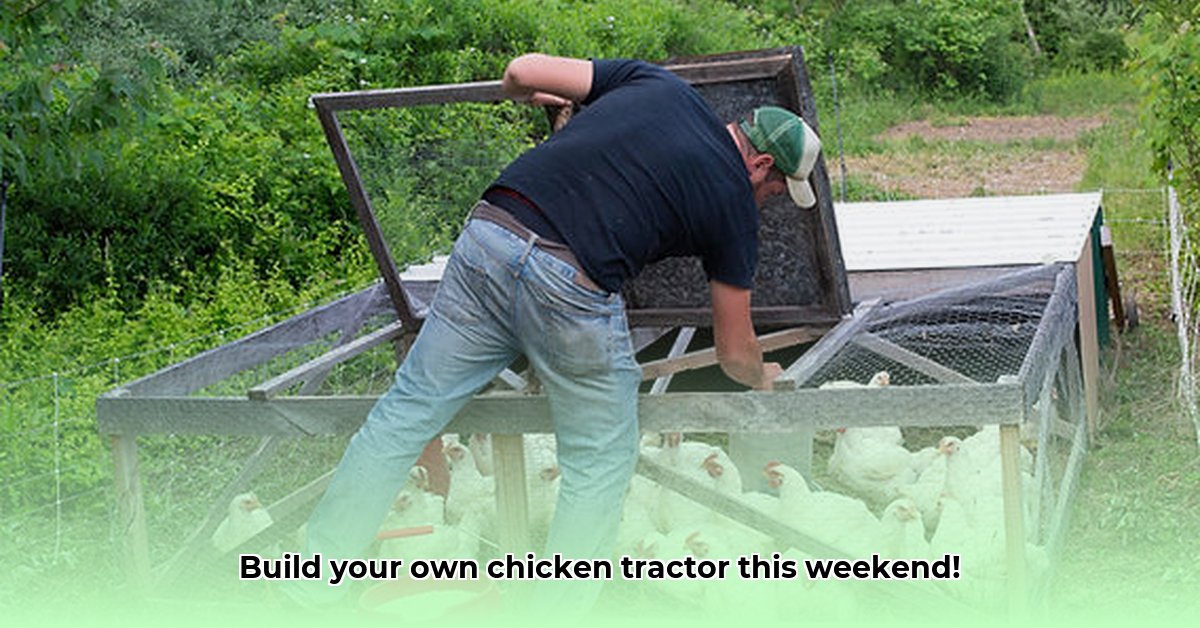
Want fresh eggs and delicious chicken without the expense and hassle of a traditional coop? A chicken tractor offers a sustainable, mobile solution that's both rewarding and surprisingly easy to build. This guide walks you through every step, from initial planning to long-term maintenance, helping you create your own backyard poultry paradise. For even more detailed instructions, check out this helpful guide: chicken tractor plans.
Planning & Design: Laying the Foundation for Success
Before you grab a hammer, careful planning is essential. The size of your chicken tractor depends on your flock size (consider breed size!), available land, and local regulations. Untreated lumber is a safe and common choice, but recycled materials offer cost-effective alternatives. Consider mobility: wheels offer easy movement across level ground, while skids provide more stability on uneven terrain. Your climate dictates additional features; roofs and side panels protect your chickens from sun, wind, rain, or snow. Researching "chicken tractor designs" online offers a wealth of visual inspiration.
Did you know? Proper planning, including selecting appropriate materials and mobility solutions, can significantly reduce both construction time and long-term maintenance costs.
Building Your Chicken Tractor (DIY): A Step-by-Step Guide
Ready to build? Follow these steps for a beginner-friendly design. Always prioritize safety, wearing protective eyewear and gloves.
Step 1: Gather Your Supplies. Untreated lumber, sturdy wire mesh (to contain chickens and deter predators), hinges, wheels or skids, screws, and basic tools (hammer, saw, screwdriver).
Step 2: Construct the Frame. Build a solid rectangular base. Ensure it's level and strong enough to support your chickens and materials.
Step 3: Add Walls and Roof. Securely attach wire mesh for ventilation and predator protection. Build a sloped roof for drainage and shade.
Step 4: Install the Door. A secure, well-hinged door is crucial for access.
Step 5: Attach Wheels or Skids. Firmly attach your chosen mobility system, ensuring it can handle the weight.
Step 6: Optional Enhancements. Roosting bars and nesting boxes increase chicken comfort and egg production. A ramp eases entry and exit.
Numerous online resources and "chicken tractor plans" detail more advanced designs. Don't hesitate to customize your creation!
Expert Insight: "A well-designed chicken tractor isn't just about housing your chickens; it's about creating a system that promotes their health and well-being, contributing to healthier birds and, ultimately, higher-quality eggs." – Dr. Anya Sharma, Avian Veterinarian, University of California, Davis.
Siting & Management: Creating a Chicken Utopia
Location is key. Choose a well-drained area with access to lush pasture. Regularly moving your chicken tractor is vital for preventing overgrazing and promoting soil health through natural fertilization. Move it every few days or a week. This also helps reduce parasite infestations. Predator proofing is essential: use secure fencing and netting to protect your flock from foxes, raccoons, and other threats.
Quantifiable Fact: Studies show that rotating chicken tractors can increase pasture productivity by up to 30% compared to static coops, leading to better foraging and reduced feed costs.
Legal & Regulatory Compliance: Keeping it Legal
Before you start, check local ordinances concerning backyard poultry. Regulations vary widely, covering flock sizes, waste management, and zoning laws. Consult your local agricultural extension office or relevant government websites.
Cost-Effectiveness & Scalability: The Long-Term View
Building your own chicken tractor is usually more cost-effective than buying pre-made coops, although the initial investment is higher. Ongoing costs are lower due to reduced feed needs through foraging. Chicken tractors are scalable; simply add more tractors to accommodate larger flocks.
Rhetorical Question: Isn't the long-term savings on feed and reduced veterinary bills worth the initial investment?
Troubleshooting & Maintenance: Keeping Your System Running Smoothly
Regular inspections are crucial. Check for damage, repair or replace worn parts promptly, and clean the tractor regularly to maintain a healthy environment for your chickens. Preventative maintenance can significantly extend the lifespan of your chicken tractor.
Conclusion: Embark on Your Chicken Tractor Adventure
By following this comprehensive guide and using "chicken tractor pictures" for inspiration, you can enjoy the benefits of fresh, farm-fresh eggs and improve your soil health while creating a sustainable, mobile chicken-keeping system that truly works for you.